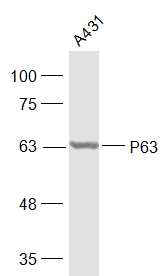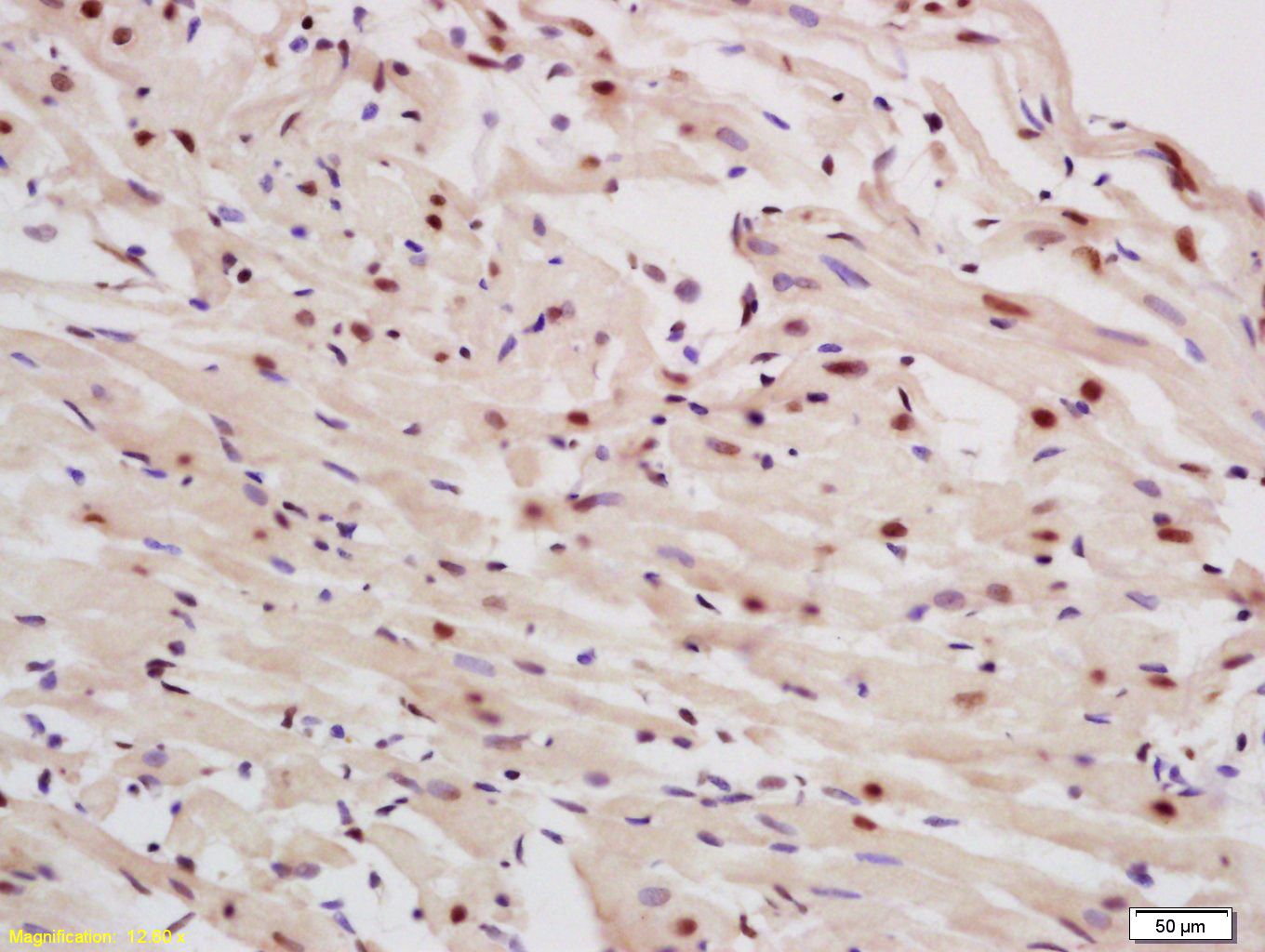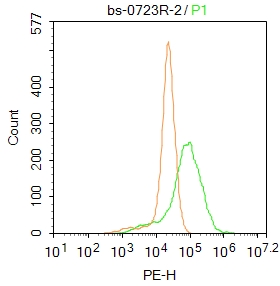
Rabbit Anti-P63 antibody
P63 protein; AIS; Amplified in squamous cell carcinoma; B(p51A); B(p51B); p63 Alpha; Chronic ulcerative stomatitis protein; CUSP; DN p63 alpha 1; DNp63; EEC3; Keratinocyte transcription factor; Keratinocyte transcription factor KET; KET; LMS; NBP; OFC8; p
View History [Clear]
Details
Product Name P63 Chinese Name Tumour抑制基因p63α抗体 Alias P63 protein; AIS; Amplified in squamous cell carcinoma; B(p51A); B(p51B); p63 Alpha; Chronic ulcerative stomatitis protein; CUSP; DN p63 alpha 1; DNp63; EEC3; Keratinocyte transcription factor; Keratinocyte transcription factor KET; KET; LMS; NBP; OFC8; p40; p51; P51/P63; p53 like transcription factor; p53 related protein; p53-related protein p63; p53CP; p63; P73; p73H; p73L; RHS; SHFM4; TP53CP; TP53L; TP63; TP73; TP73L; Transformation related protein 63; Trp53rp1; Trp63; Tumor protein 63; tumor protein 63 kDa with strong homology to p53; Tumor protein p53-competing protein; Tumor protein p53-like; tumor protein p63; Tumor protein p73; tumor protein p73-like; P63_HUMAN. literatures Research Area Tumour Cell biology immunology Signal transduction transcriptional regulatory factor Immunogen Species Rabbit Clonality Polyclonal React Species Human, Rat, (predicted: Mouse, Dog, Pig, Cow, Horse, Rabbit, Sheep, Guinea Pig, ) Applications WB=1:500-2000 ELISA=1:5000-10000 IHC-P=1:100-500 IHC-F=1:100-500 Flow-Cyt=1ug/Test IF=1:100-500 (Paraffin sections need antigen repair)
not yet tested in other applications.
optimal dilutions/concentrations should be determined by the end user.Theoretical molecular weight 77kDa Cellular localization The nucleus Form Liquid Concentration 1mg/ml immunogen KLH conjugated synthetic peptide derived from human P63 protein: 361-450/680 Lsotype IgG Purification affinity purified by Protein A Buffer Solution 0.01M TBS(pH7.4) with 1% BSA, 0.03% Proclin300 and 50% Glycerol. Storage Shipped at 4℃. Store at -20 °C for one year. Avoid repeated freeze/thaw cycles. Attention This product as supplied is intended for research use only, not for use in human, therapeutic or diagnostic applications. PubMed PubMed Product Detail This gene encodes a member of the p53 family of transcription factors. An animal model, p63 -/- mice, has been useful in defining the role this protein plays in the development and maintenance of stratified epithelial tissues. p63 -/- mice have several developmental defects which include the lack of limbs and other tissues, such as teeth and mammary glands, which develop as a result of interactions between mesenchyme and epithelium. Mutations in this gene are associated with ectodermal dysplasia, and cleft lip/palate syndrome 3 (EEC3); split-hand/foot malformation 4 (SHFM4); ankyloblepharon-ectodermal defects-cleft lip/palate; ADULT syndrome (acro-dermato-ungual-lacrimal-tooth); limb-mammary syndrome; Rap-Hodgkin syndrome (RHS); and orofacial cleft 8. Both alternative splicing and the use of alternative promoters results in multiple transcript variants encoding different proteins. Many transcripts encoding different proteins have been reported but the biological validity and the full-length nature of these variants have not been determined. [provided by RefSeq, Jul 2008].
Function:
Acts as a sequence specific DNA binding transcriptional activator or repressor. The isoforms contain a varying set of transactivation and auto-regulating transactivation inhibiting domains thus showing an isoform specific activity. May be required in conjunction with TP73/p73 for initiation of p53/TP53 dependent apoptosis in response to genotoxic insults and the presence of activated oncogenes. Involved in Notch signaling by probably inducing JAG1 and JAG2. Plays a role in the regulation of epithelial morphogenesis. The ratio of DeltaN-type and TA*-type isoforms may govern the maintenance of epithelial stem cell compartments and regulate the initiation of epithelial stratification from the undifferentiated embryonal ectoderm. Required for limb formation from the apical ectodermal ridge.
Subunit:
Binds DNA as a homotetramer. Isoform composition of the tetramer may determine transactivation activity. Isoforms Alpha and Gamma interact with HIPK2. Interacts with SSRP1, leading to stimulate coactivator activity. Isoform 1 and isoform 2 interact with WWP1. Interacts with PDS5A. Isoform 5 (via activation domain) interacts with NOC2L.
Subcellular Location:
Nucleus.
Tissue Specificity:
Widely expressed, notably in heart, kidney, placenta, prostate, skeletal muscle, testis and thymus, although the precise isoform varies according to tissue type. Progenitor cell layers of skin, breast, eye and prostate express high levels of DeltaN-type isoforms. Isoform 10 is predominantly expressed in skin squamous cell carcinomas, but not in normal skin tissues.
Post-translational modifications:
May be sumoylated.
Ubiquitinated. Polyubiquitination involves WWP1 and leads to proteasomal degradation of this protein.
DISEASE:
Defects in TP63 are the cause of acro-dermato-ungual-lacrimal-tooth syndrome (ADULT syndrome) [MIM:103285]; a form of ectodermal dysplasia. Ectodermal dysplasias (EDs) constitute a heterogeneous group of developmental disorders affecting tissues of ectodermal origin. EDs are characterized by abnormal development of two or more ectodermal structures such as hair, teeth, nails and sweat glands, with or without any additional clinical sign. Each combination of clinical features represents a different type of ectodermal dysplasia. ADULT syndrome involves ectrodactyly, syndactyly, finger- and toenail dysplasia, hypoplastic breasts and nipples, intensive freckling, lacrimal duct atresia, frontal alopecia, primary hypodontia, and loss of permanent teeth. ADULT differs significantly from EEC3 syndrome by the absence of facial clefting.
Similarity:
Belongs to the p53 family.
Contains 1 SAM (sterile alpha motif) domain.
SWISS:
Q9H3D4
Gene ID:
8626
Database links:Entrez Gene: 8626 Human
Entrez Gene: 22061 Mouse
Omim: 603273 Human
SwissProt: Q9H3D4 Human
SwissProt: O88898 Mouse
Unigene: 137569 Human
Unigene: 20894 Mouse
Unigene: 42907 Rat
P63—也是Tumour抑制因子之一.p63基因是抑癌基因p53的同源性基因,主要表达上皮组织的基底细胞或复层epithelial cells,如皮肤、食道、宫颈外口、扁桃体、膀胱等,和前列腺、乳腺腺样结构的基层细胞。Product Picture
A431(Human) Cell Lysate at 30 ug
Primary: Anti-P63 (SL0723R) at 1/1000 dilution
Secondary: IRDye800CW Goat Anti-Rabbit IgG at 1/20000 dilution
Predicted band size: 77 kD
Observed band size: 62 kD
Tissue/cell: rat heart tissue; 4% Paraformaldehyde-fixed and paraffin-embedded;
Antigen retrieval: citrate buffer ( 0.01M, pH 6.0 ), Boiling bathing for 15min; Block endogenous peroxidase by 3% Hydrogen peroxide for 30min; Blocking buffer (normal goat serum,C-0005) at 37℃ for 20 min;
Incubation: Anti-P63 protein/P51A Polyclonal Antibody, Unconjugated(SL0723R) 1:200, overnight at 4°C, followed by conjugation to the secondary antibody(SP-0023) and DAB(C-0010) staining
Blank control: A549.
Primary Antibody (green line): Rabbit Anti-P63(TP63) antibody (SL0723R)
Dilution: 1μg /10^6 cells;
Isotype Control Antibody (orange line): Rabbit IgG .
Secondary Antibody : Goat anti-rabbit IgG-PE
Dilution: 1μg /test.
Protocol
The cells were fixed with 4% PFA (10min at room temperature)and then permeabilized with PBST for 20 min at room temperature. The cells were then incubated in 5%BSA to block non-specific protein-protein interactions for 30 min at room temperature .Cells stained with Primary Antibody for 30 min at room temperature. The secondary antibody used for 40 min at room temperature. Acquisition of 20,000 events was performed.
Bought notes(bought amounts latest0)
No one bought this product
User Comment(Total0User Comment Num)
- No comment





 +86 571 56623320
+86 571 56623320
 +86 18668110335
+86 18668110335

